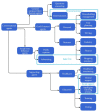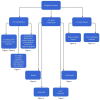Conversational Agents: Goals, Technologies, Vision and Challenges
- PMID: 34960538
- PMCID: PMC8704682
- DOI: 10.3390/s21248448
Conversational Agents: Goals, Technologies, Vision and Challenges
Abstract
In recent years, conversational agents (CAs) have become ubiquitous and are a presence in our daily routines. It seems that the technology has finally ripened to advance the use of CAs in various domains, including commercial, healthcare, educational, political, industrial, and personal domains. In this study, the main areas in which CAs are successful are described along with the main technologies that enable the creation of CAs. Capable of conducting ongoing communication with humans, CAs are encountered in natural-language processing, deep learning, and technologies that integrate emotional aspects. The technologies used for the evaluation of CAs and publicly available datasets are outlined. In addition, several areas for future research are identified to address moral and security issues, given the current state of CA-related technological developments. The uniqueness of our review is that an overview of the concepts and building blocks of CAs is provided, and CAs are categorized according to their abilities and main application domains. In addition, the primary tools and datasets that may be useful for the development and evaluation of CAs of different categories are described. Finally, some thoughts and directions for future research are provided, and domains that may benefit from conversational agents are introduced.
Keywords: conversational agents; human–agent interaction; smart environments.
Conflict of interest statement
The authors declare no conflict of interest.
Figures











References
-
- Bosker B. Siri Rising: The Inside Story of Siri’s Origins—And Why She Could Overshadow the Iphone. Huffington Post. [(accessed on 9 December 2021)]. Available online: https://www.huffpost.com/entry/siri-do-engine-apple-iphone_n_2499165.
-
- Adiwardana D., Luong M.T., So D.R., Hall J., Fiedel N., Thoppilan R., Yang Z., Kulshreshtha A., Nemade G., Lu Y., et al. Towards a human-like open-domain chatbot. arXiv. 20202001.09977
-
- Bhat H.R., Lone T.A., Paul Z.M. Cortana-intelligent personal digital assistant: A review. Int. J. Adv. Res. Comput. Sci. 2017;8:55–57.
-
- Adamopoulou E., Moussiades L. Chatbots: History, Technology, and Applications. Mach. Learn. Appl. 2020;2:100006. doi: 10.1016/j.mlwa.2020.100006. - DOI
-
- Adamopoulou E., Moussiades L. An overview of chatbot technology; Proceedings of the IFIP International Conference on Artificial Intelligence Applications and Innovations; Neos Marmaras, Greece. 5–7 June 2020; Cham, Switzerland: Springer Nature; 2020. pp. 373–383.
Publication types
MeSH terms
LinkOut - more resources
Full Text Sources

